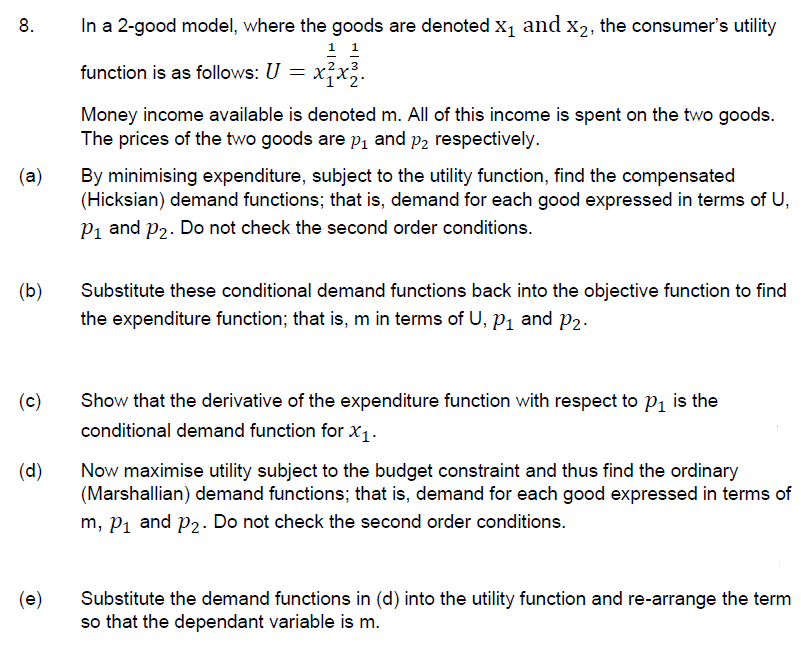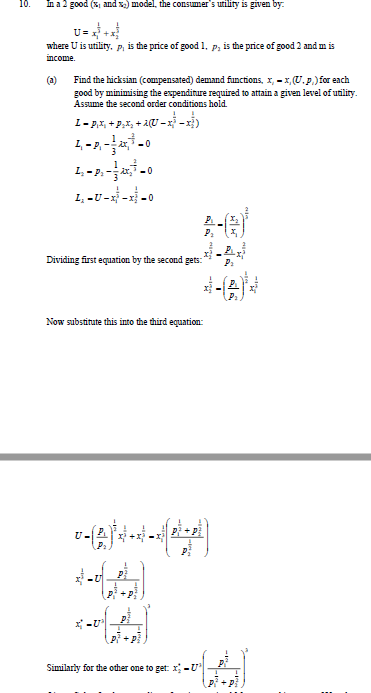8. In a 2-good model, where the goods are denoted x, and x,, the consumer's utility 1 1 function is as follows: U = x,x3. Money income available is denoted m. All of this income is spent on the two goods. The prices of the two goods are P1 and p2 respectively. (a) By minimising expenditure, subject to the utility function, find the compensated (Hicksian) demand functions; that is, demand for each good expressed in terms of U, P1 and P2. Do not check the second order conditions. (b) Substitute these conditional demand functions back into the objective function to find the expenditure function; that is, m in terms of U, P1 and p2.
8. In a 2-good model, where the goods are denoted x, and x,, the consumer's utility 1 1 function is as follows: U = x,x3. Money income available is denoted m. All of this income is spent on the two goods. The prices of the two goods are P1 and p2 respectively. (a) By minimising expenditure, subject to the utility function, find the compensated (Hicksian) demand functions; that is, demand for each good expressed in terms of U, P1 and P2. Do not check the second order conditions. (b) Substitute these conditional demand functions back into the objective function to find the expenditure function; that is, m in terms of U, P1 and p2.
Chapter5: Income And Substitution Effects
Section: Chapter Questions
Problem 5.5P
Related questions
Question
Can you please help awnser 8 b I have attached awnser to 8 a to make it easier to understand and complete.
Thank you

Transcribed Image Text:8.
In a 2-good model, where the goods are denoted x, and x2, the consumer's utility
1 1
function is as follows: U =
Money income available is denoted m. All of this income is spent on the two goods.
The prices of the two goods are P1 and p2 respectively.
(a)
By minimising expenditure, subject to the utility function, find the compensated
(Hicksian) demand functions; that is, demand for each good expressed in terms of U,
P1 and P2. Do not check the second order conditions.
(b)
Substitute these conditional demand functions back into the objective function to find
the expenditure function; that is, m in terms of U, P, and p2.
(c)
Show that the derivative of the expenditure function with respect to P1 is the
conditional demand function for x1-
(d)
Now maximise utility subject to the budget constraint and thus find the ordinary
(Marshallian) demand functions; that is, demand for each good expressed in terms of
m, Pi and P2. Do not check the second order conditions.
(e)
Substitute the demand functions in (d) into the utility function and re-arrange the term
so that the dependant variable is m.

Transcribed Image Text:10.
In a 2 good (8, and x) model, the consumer's utility is given by:
U= +
where U is utility. P, is the price of good 1. p, is the price of good 2 and m is
income.
Find the hicksian (compensated) demand functions, x, - x, (U.p.) for each
good by minimising the expenditure required to attain a given level of utility.
Assume the second order conditions hold.
(a)
1-pX, +P,X, + 2U -x - x)
1.-2.--0
1, -U ---0
Dividing first equation by the second gets:
Now substitute this into the third equation:
P +P
x -U*
pi + p
Similarly for the other one to get: x -U
Expert Solution
This question has been solved!
Explore an expertly crafted, step-by-step solution for a thorough understanding of key concepts.
Step by step
Solved in 2 steps

Knowledge Booster
Learn more about
Need a deep-dive on the concept behind this application? Look no further. Learn more about this topic, economics and related others by exploring similar questions and additional content below.Recommended textbooks for you

